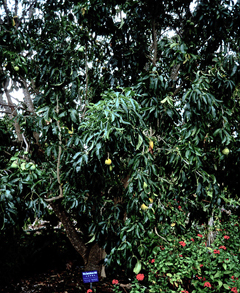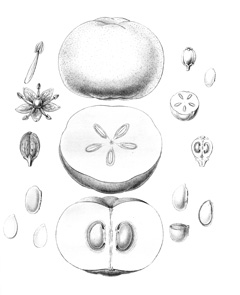 |
|
https://edibleplants.org/ |
 |
| https://edibleplants.org/ |
Translate this page:
Summary
White Sapote or Casimiroa edulis is a fruit tree of about 18 m tall that can be found in Central America. It has drooping and spreading branches, its leaves are compound palmate and arranged alternately, and its fruits are ovoid drupes. The fruit is consumed either raw or cooked but its seeds are reportedly toxic if eaten raw. Medicinally, white sapote?s different plant parts are used as sedative or as treatment for diabetes, arthritis, rheumatism, and putrid sores.
Physical Characteristics

 Casimiroa_edulis is an evergreen Tree growing to 16 m (52ft) by 16 m (52ft) at a medium rate.
Casimiroa_edulis is an evergreen Tree growing to 16 m (52ft) by 16 m (52ft) at a medium rate.
See above for USDA hardiness. It is hardy to UK zone 9. The flowers are pollinated by Bees.
It is noted for attracting wildlife.
Suitable for: light (sandy), medium (loamy) and heavy (clay) soils and prefers well-drained soil. Suitable pH: mildly acid, neutral and basic (mildly alkaline) soils and can grow in very alkaline and saline soils.
It cannot grow in the shade. It prefers moist soil and can tolerate drought.
UK Hardiness Map
US Hardiness Map
Synonyms
Fagara bobacifolia (A.Rich.) Krug. & Urb. Zanthoxylum araliaceum Turcz. Zanthoxylum bombacifolium A.
Plant Habitats
Edible Uses
Edible portion: Fruit, Seeds, Nut. Fruit - raw or cooked[ 200 ]. A sweet flavour, though the butter-textured flesh can be resinous[ 200 ]. The flavour is peach-like[ 307 ]. The fruit has a remarkably high food value, almost as rich in protein, carbohydrate and vitamins as a banana[ 200 ]. The yellow-green fruit is up to 10cm long[ 200 , 307 ]. Eating the fruit has long been known to produce drowsiness. Some reports say that the seed is toxic if eaten raw, whilst others say that it can be roasted and eaten like nuts[ 301 ].
References More on Edible Uses
Medicinal Uses
Plants For A Future can not take any responsibility for any adverse effects from the use of plants. Always seek advice from a professional before using a plant medicinally.
The leaves, bark, and especially the seeds contain a glucoside called casimirosine that has sedative activity[ 307 ]. They have been employed as sedatives, soporifics and tranquilizers[ 303 ]. In Costa Rica, the leaf decoction is taken as a treatment for diabetes[ 303 ]. Eating the fruit produces drowsiness and it is widely claimed in Mexico and Central America that consumption of the fruit relieves the pains of arthritis and rheumatism[ 303 ]. The fruit is also reportedly vermifugal[ 303 ]. The seeds contain a number of alkaloids which are narcotic with soporific activity[ 303 ]. Crushed and roasted seeds are effective in healing putrid sores[ 303 ]. Vasodepressive activity of the white sapote is attributed to Na-dimethy-1-histamine, formerly found in nature only in the sponge, Geodia gigas[ 303 ]. Several recent in vitro studies have shown that zapotin - found in the seeds - has potential anti-carcinogenic effects against isolated colon cancer cells.
References More on Medicinal Uses
The Bookshop: Edible Plant Books
Our Latest books on Perennial Plants For Food Forests and Permaculture Gardens in paperback or digital formats.

Edible Tropical Plants
Food Forest Plants for Hotter Conditions: 250+ Plants For Tropical Food Forests & Permaculture Gardens.
More

Edible Temperate Plants
Plants for Your Food Forest: 500 Plants for Temperate Food Forests & Permaculture Gardens.
More

More Books
PFAF have eight books available in paperback and digital formats. Browse the shop for more information.
Shop Now
Other Uses
Other uses rating: Low (2/5). Small shade tree, Small fruit tree, Agricultural shade, Screening, Backyard tree. Other Uses The seed is said to be fatally toxic if eaten raw by humans or animals. Extractions from the kernels are an attractive and lethal bait for American cockroaches, having the advantage of killing on the spot rather than at some distance after ingestion of the poison[ 303 ]. The wood is yellow, fine-grained, compact, moderately dense and heavy, medium strong and resistant, but not durable for long. It is occasionally employed in carpentry and for domestic furniture[ 303 ].
Special Uses
References More on Other Uses
Cultivation details
Plants are about as hardy as a lemon (Citrus limon)[ 200 ], which means that they can tolerate occasional frosts. In tropical latitudes the plant can be found at elevations between 700 - 3,000 metres, but it is best grown between 1,000 - 2,000 metres[ 303 ]. In subtropical climate it can be grown at sea level[ 303 ]. It is distinctly subtropical in its climatic requirements, surviving light frosts. On the other hand, flowering during the coldest months tends to result in poor fruit set[ 303 ]. Plants are unlikely to do well in lowland tropical areas, especially in the wetter regions[ K ]. Temperature range for growth is reported to be 14 - 31c with the optimum between 18 - 26c. Temperatures around -1 to -2c may injure young growing shoots and cause fruit drop, whereas temperatures about -3 to -4?c may kill the tree to the ground. Annual rainfall range for growth is reported to be 500 - 4,000mm with the optimum between 1,500 - 3,000mm[ 303 ]. Prefers an open, well-drained site on a loamy soil[ 200 ]. Prefers a pH in the range 7 - 7.5, tolerating 6.5 - 8[ 418 ]. Established plants are drought resistant, though they need adequate moisture if they are to fruit well[ 200 ]. Seedling trees usually begin to bear in 7 - 8 years[ 303 ]. Grafted trees start bearing in 3 - 4 years[ 303 ]. Trees can flower and produce fruit at more than one time of the year[ 377 ]. A mature tree can produce more than 100 kilos of fruit a year[ 377 ]. There are many named varieties[ 200 ] . Frequent light pruning is possible to increase the number of fruiting arms but pruning should not be too heavy. Fruit are picked when colour changes occur and ripened off the tree. They can be stored at 5C for 3-6 weeks. Adding potash prior to fruiting and nitrogen prior to vegetative regrowth is suggested for increased yield. Fruit yields are high. Fruit are easily damaged.
References Carbon Farming Information and Carbon Sequestration Information
Temperature Converter
Type a value in the Celsius field to convert the value to Fahrenheit:
Fahrenheit:
The PFAF Bookshop
Plants For A Future have a number of books available in paperback and digital form. Book titles include Edible Plants, Edible Perennials, Edible Trees,Edible Shrubs, Woodland Gardening, and Temperate Food Forest Plants. Our new book is Food Forest Plants For Hotter Conditions (Tropical and Sub-Tropical).
Shop Now
Plant Propagation
Seed - sow in containers. Trees produce taproots, so the seed should be sown in deep containers and the plants moved straight to their permanent positions once they are large enough[ 377 ]. Seed of cultivars does not breed true[ 200 ]. Layering[ 200 ]. Commercial growers in New Zealand have had success with air-layers[ 303 ]. Cuttings are very difficult to root[ 303 ]. Grafting. Seedlings of the cultivar 'Pike', being vigorous growers, are preferred as rootstock. Shield-budding and side-grafting in spring onto stocks up to 2 cm thick give good results. Cleft grafts and slot grafts are made on larger rootstocks and when top working mature trees[ 303 ].
Other Names
If available other names are mentioned here
White Sapote or Casimiroa edulis. Other Names: Casimiroa, White sapote, Matasano, Mexican apple, Zapote.
Native Range
NORTHERN AMERICA: Mexico, San Luis Potosí, Hidalgo, Jalisco, México, Michoacán de Ocampo, Morelos, Oaxaca, Querétaro, Veracruz de Ignacio de la Llave, Ciudad de México, SOUTHERN AMERICA: Costa Rica, Guatemala, El Salvador,
Weed Potential
Right plant wrong place. We are currently updating this section.
Please note that a plant may be invasive in one area but may not in your area so it's worth checking.
None Known
Conservation Status
IUCN Red List of Threatened Plants Status : This taxon has not yet been assessed.

Growth: S = slow M = medium F = fast. Soil: L = light (sandy) M = medium H = heavy (clay). pH: A = acid N = neutral B = basic (alkaline). Shade: F = full shade S = semi-shade N = no shade. Moisture: D = dry M = Moist We = wet Wa = water.
Now available:
Food Forest Plants for Mediterranean Conditions
350+ Perennial Plants For Mediterranean and Drier Food Forests and Permaculture Gardens.
[Paperback and eBook]
This is the third in Plants For A Future's series of plant guides for food forests tailored to
specific climate zones. Following volumes on temperate and tropical ecosystems, this book focuses
on species suited to Mediterranean conditions—regions with hot, dry summers and cool, wet winters,
often facing the added challenge of climate change.
Read More
Expert comment
Author
La Llave.
Botanical References
Links / References
For a list of references used on this page please go here
A special thanks to Ken Fern for some of the information used on this page.
Readers comment
| Add a comment |
|
If you have important information about this plant that may help other users please add a comment or link below. Only comments or links that are felt to be directly relevant to a plant will be included. If you think a comment/link or information contained on this page is inaccurate or misleading we would welcome your feedback at [email protected]. If you have questions about a plant please use the Forum on this website as we do not have the resources to answer questions ourselves.
* Please note: the comments by website users are not necessarily those held by PFAF and may give misleading or inaccurate information.
To leave a comment please Register or login here All comments need to be approved so will not appear immediately.
|
Subject : Casimiroa_edulis
|
|
|
|